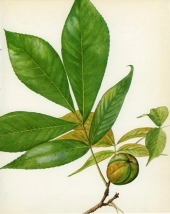Hello Laura!
Great post and thanks for sharing your list of plants for your riparian plantings. I run the environmental restoration program for a non-profit here in western WA. And as Anne mentioned (thanks for the call out!

) my wife and I also run a blog called
Wild Homesteading and I post here a fair bit. I really love this sort work and on my own property I'm actively working on creating new wetlands and adding complexity to the seasonal stream that flows through it. My ultimate goal is to have surface water on my property year round and not just fall through spring.
I think adding complexity to these sort of habitats when possible is a great option though it depends on what the existing conditions are--care needs to be taken when dealing with fish bearing streams for example. In my case the seasonal stream was a single channel that ran mostly straight and was eroding downwards. Part of what I've been doing is creating ponds and using those ponds to raise the water level up out of the eroded sections to reconnect the stream with surrounding higher ground. The result is what was a single channel stream is now a multi-channel stream. I'm also adding meanders to other areas and creating waterfalls which improve oxygenation of the water. There are no fish in the stream and since it goes dry in late spring or early summer I haven't had to worry too much about having a negative impact to existing aquatic life. The surrounding land is just degraded pasture so very little existing vegetation other than pasture grasses. Basically a clean slate to do work in.
The result of all this is an increase in the overall amount of stream bank and aquatic habitat. Plus, the water is slowed and spread by the meanders and ponds/pools which will hopefully raise the groundwater level under my property and downstream (large wetland downstream with a large pond) which in turn will hopefully help keep water in my ponds over the summer.
In the upper areas of my property the soils are all clay. In one area I'm planning to build a swale to capture and transport water from a pond I put at the mouth of a stormwater culvert. The swale will take the water upstream--since the stream is lower than this pond I can follow the contour line with the swale to a section of the stream that is at a higher elevation further upstream. The result is the water from the stormwater culvert can be moved further upstream in relation to the water in the stream before it flows into the stream. But since the soils are all clay in this area I'm planning to make a wider than needed swale and only use about 66% of the dug out material to build the swale berm. The rest of the removed clay will be used to help seal up sections of the large ponds I'm building along the seasonal stream.
These ponds are created by building earthen dams across the seasonal stream--these are relatively small with a max height of 4 feet and are built by hand using a shovel. I want to seal the dams using the clay from further up so the water has to travel downward into the ground instead of forward through the dams as they slowly do now. High flows go over spillways that I'm planning to improve so they function more as a series of cascading waterfalls to help oxygenate the water.
I've built 3 of these dams so far and the first and largest has held up to a record rainfall event so they're fairly stable. I did have to widen the spillways to keep the largest dam from being over topped but otherwise this approach seems to be working.
There's more water capture features that I'm building or want to build including some ponds at the highest points on my property that may be filled by pumping excess water from the lowest ponds (using solar). I've also started building some terraces to slow more water down and I'm capturing stormwater runoff from a dirt road. The basic goal of all of this is just to keep water on my property for as long as possible and to greatly expand the aquatic habitat available for wildlife.
But I also want to grow food on my property so I'm striving for a balance with food crops and native plants.
In one area just upstream of my largest pond I'm working on creating a small island that I'm calling my blueberry island. This island will be setup to function as a bog with the blueberries growing on a series of mounds in the bog. This will keep their roots a bit out of the water but they will still have access to it. The soils should also stay naturally acidic. All of this I hope will result in bumper blueberry crops.
Most of my food forests will be planted on higher ground above the core wetland area which is along the seasonal stream. But I hope to grow a lot of native edibles that like wet areas like salmonberry, wapato (arrowleaf), cattails, springbank clover, silverweed, and others. There are also some non-native edibles that I may grow in these areas and I may plant cool weather vegetables like spinach on the sunny sides of the blueberry mounds on that island. This area will stay cool and moist longer into the year so spinach and some other food crops may do better there than in my main gardens.
I'm also planning to grow alders, cottonwoods, some Oregon ash, willows, red oiser dogwood, and some red cedars along the wet areas. Many of these will be coppiced or cut down later on to add woody debris to the wetland areas to improve the overall habitat. The cedars and some other large trees will be left to ultimately provide the core habitat and shade. Around the ponds I may plant large fruit trees or nut trees assuming the area isn't too wet for them. I might grow native maples in some of these areas to provide a lot of shade so the ponds don't get too hot.
While I do hope to get a lot of food from these wet areas the priority will be the creation of wildlife habitat. I hope it becomes a magnet for all sorts of wildlife!
I will try to post a list of riparian plants native to this area later.
Thanks again for sharing Laura--always great to chat about this sort of thing!


 9
9




 3
3




 5
5




 9
9




 ) my wife and I also run a blog called Wild Homesteading and I post here a fair bit. I really love this sort work and on my own property I'm actively working on creating new wetlands and adding complexity to the seasonal stream that flows through it. My ultimate goal is to have surface water on my property year round and not just fall through spring.
) my wife and I also run a blog called Wild Homesteading and I post here a fair bit. I really love this sort work and on my own property I'm actively working on creating new wetlands and adding complexity to the seasonal stream that flows through it. My ultimate goal is to have surface water on my property year round and not just fall through spring.




 4
4





 2
2






 2
2




 3
3




 5
5



















